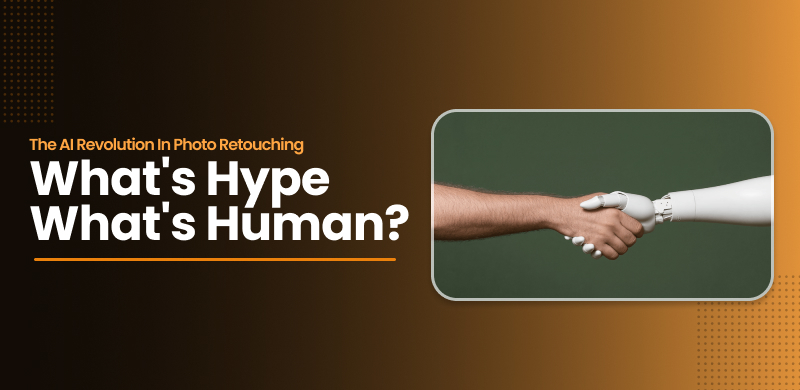It’s something that’s been on everyone’s tongues lately, and candidly speaking, it is a fair question. With AI software now apparently able to do everything from creating articles to constructing entire images from scratch, where does this leave the skill of photo retouching ? Are we now at the stage where you can just click a button and have the perfect, professional-standard picture?
The short answer is… sometimes. The longer answer is that AI is an amazing tool, but it’s not a substitute, it’s a team member. In high-risk visual material, there is still a role for the human touch. So let’s discuss when it is right to let AI take the heavy lifting and, more crucially, when a talented human retoucher is your most valuable resource.
For further insights, get a deeper dive into Product Photo Retouching Services: Cost-Effective Background Fixes
When AI Shines in Photo Retouching
AI has its strengths—it’s fast, affordable, and efficient with repetitive edits.
- Background Removal at Scale
Need 1,000 product images cleaned up for white-background consistency? AI tools can process those in bulk within minutes. For businesses managing catalogs, this is a game-changer. - Basic Color & Exposure Adjustments
AI is surprisingly good at fixing exposure issues, balancing brightness, and correcting white balance. It saves time when you need quick, uniform results. - Clipping Paths & Simple Cutouts
For straightforward shapes (like boxes, bottles, or packaged goods), AI delivers neat, precise edges without a human spending hours on manual paths. - Cost-Effective First Drafts
AI-generated edits often serve as a “first pass.” Human editors can then refine them instead of starting from scratch, reducing turnaround times.
So yes, AI is efficient. But efficiency doesn’t equal perfection.
Where AI Still Falls Short
AI isn’t flawless, and its blind spots are often where brand trust is at stake.
- Complex Surfaces & Textures
Think jewelry, fabrics, or glossy car exteriors. AI struggles to preserve fine textures without flattening them. Human photo retouching makes subtle enhancements while keeping the product believable. - Skin & Portraits
AI tools often make skin look plastic or unnatural. Humans know where to leave natural lines, shadows, and tones so the person still looks real. - Creative Judgment
AI doesn’t “get” brand aesthetics. For example, some brands want warmer tones to feel approachable, while others want cool tones for a sleek vibe. Only a trained human retoucher can interpret those nuances. - Avoiding Overcorrection
AI sometimes erases details that should be there—a crease in fabric, natural reflection, or subtle gradient. Humans know which imperfections to keep for realism.
The Hybrid Model: Best of Both Worlds
The smartest businesses today don’t choose one over the other—they combine them.
Here’s how:
- AI handles the heavy lifting: bulk edits, background removals, exposure corrections.
- Humans step in for finesse: adjusting textures, enhancing details, and ensuring brand consistency.
This hybrid approach saves time, lowers costs, and still delivers the quality that builds trust. A raw AI edit may look “good enough,” but a human-polished image is what makes a customer click Buy Now.
Case in Point: Why Human Touch Still Wins
- A jewelry retailer used AI-only edits for product shots. The stones looked clean, but the sparkle—the very thing that sells jewelry—was missing. When retouchers stepped in, they highlighted brilliance without making it look fake. Sales improved.
- A fashion brand relied on AI for model photos. The edits smoothed skin but erased texture, making garments look flat. Human retouching brought back the richness of fabrics, helping customers trust what they’d receive.
- A dealership showcased cars online with AI-edited images. While reflections were removed, so were natural highlights that made the paint look glossy. Human editors reintroduced depth, making the cars look showroom-ready.
Each case shows why the human touch isn’t about rejecting AI—it’s about knowing where it can’t be trusted to make the right call.
Why Businesses Should Care
In e-commerce, visuals aren’t decoration, they’re conversion tools. Customers decide in seconds whether to trust your product or not. Photo retouching plays a direct role in that decision. AI can help you scale fast, but human retouching ensures authenticity. The brands winning today are the ones that don’t chase speed at the expense of trust.
Conclusion:
AI in photo retouching isn’t the enemy, it’s an assistant. Use it for speed, efficiency, and repetitive edits. But when it comes to brand identity, fine details, and creative judgment, the human touch is still irreplaceable. If you’re serious about growth, don’t ask whether you should choose AI or human retouching. Ask how you can combine the two to get fast, cost-effective, and trustworthy results. Because at the end of the day, customers don’t care whether AI or a human polished the photo, they just care if it makes them click.

